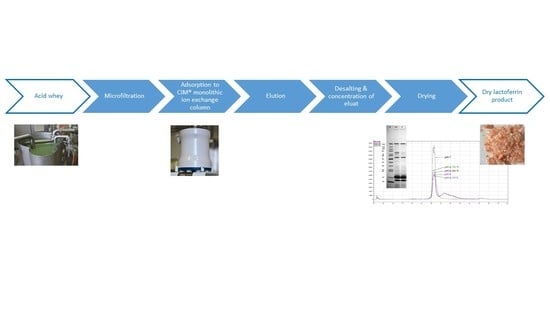Characterisation of Lactoferrin Isolated from Acid Whey Using Pilot-Scale Monolithic Ion-Exchange Chromatography
Abstract
1. Introduction
2. Materials and Methods
2.1. Pilot System for the Processing of Acid Whey—Isolation of LF
2.2. Determination of Lactoferrin Content in Acid Whey by HPLC
2.3. SDS-PAGE Analysis of Protein Composition of Dried Lactoferrin
2.4. C-Value and A-Value Determination
2.5. pH and Temperature Stability Using Fluorescence and UV–VIS Spectrophotometry
2.6. Qualitative Assessment of Antimicrobial Activity of LF by Agar Diffusion Assay
2.7. Determination of Antimicrobial Activity (MIC) of LF by Microdilution Assay
2.8. Statistical Evaluation
3. Results and Discussion
3.1. Composition of Incoming Acid Whey and Whey Fractions after Processing
3.2. Characterisation of Dried Lactoferrin Produced on a Pilot Plant
3.3. Temperature and pH Stability of the Produced Lactoferrin
3.4. Biological—Antimicrobial Activity of Lactoferrin Produced in a Pilot Plant
3.5. The Effect of Heat Treatment on Antibacterial Activity of Lactoferrin
4. Conclusions
Author Contributions
Funding
Conflicts of Interest
References
- Jelen, P. Whey Processing-Utilization and Products. In Encyclopedia of Dairy Sciences, 2nd ed.; Academic Press: New York, NY, USA, 2011; Volume 4, pp. 731–737. [Google Scholar]
- Krolczyk, J.B.; Dawidziuk, T.; Janiszewska-Turak, E.; Solowiej, B. Use of Whey and Whey Preparations in the Food Industry—A Review. Pol. J. Food Nutr. Sci. 2016, 66, 157–165. [Google Scholar] [CrossRef]
- Božanić, R.; Barukčić, I.; Lisak, K.; Jakopović, K.L.; Tratnik, L. Possibilities of Whey Utilisation. Austin J. Nutr. Food Sci. 2014, 2, 1036. [Google Scholar]
- Erichson, B.E. Acid Whey: Is the Waste Product an Untapped Gold Mine? Chem. Eng. News 2017, 95, 26–30. [Google Scholar]
- Barukcic, I.; Jakopovic, K.L.; Bozanic, R. Valorisation of Whey and Buttermilk for Production of Functional Beverages-An Overview of Current Possibilities. Food Technol. Biotech. 2019, 57, 448–460. [Google Scholar] [CrossRef] [PubMed]
- Mollea, C.; Marmo, L.; Bosco, F. Valorisation of Cheese Whey, a By-Product from the Dairy Industry. In Food Industry; Mazzalupo, I., Ed.; InTECH: Vienna, Austria, 2013; pp. 549–588. Available online: http://dx.doi.org/10.5772/53159 (accessed on 30 May 2020).
- Iglesias-Figueroa, B.F.; Espinoza-Sánchez, E.A.; Siqueiros-Cendón, T.S.; Rascón-Cruz, Q. Lactoferrin as a Nutraceutical Protein from Milk, an overview. Int. Dairy J. 2019, 89, 37–41. [Google Scholar] [CrossRef]
- Gonzalez-Chavez, S.A.; Arevalo-Gallegos, S.; Rascon-Cruz, Q. Lactoferrin: Structure, Function and Applications. Int. J. Antimicrob. Agents 2009, 33, 301–308. [Google Scholar] [CrossRef]
- Demmelmair, H.; Prell, C.; Timby, N.; Lonnerdal, B. Benefits of Lactoferrin, Osteopontin and Milk Fat Globule Membranes for Infants. Nutrients 2017, 9, 817. [Google Scholar] [CrossRef] [PubMed]
- Hassoun, L.A.; Sivamani, R.K. A Systematic Review of Lactoferrin Use in Dermatology. Crit. Rev. Food Sci. Nutr. 2017, 57, 3632–3639. [Google Scholar] [CrossRef] [PubMed]
- Chen, L.; Guo, C.; Guan, Y.P.; Liu, H.Z. Isolation of Lactoferrin from Acid Whey by Magnetic Affinity Separation. Sep. Purif. Technol. 2007, 56, 168–174. [Google Scholar] [CrossRef]
- Noh, K.H.; Rhee, M.S.; Imm, J.Y. Separation of Lactoferrin from Model Whey Protein Mixture by Reverse Micelles Formed by Cationic Surfactant. Food Sci. Biotechnol. 2005, 14, 131–136. [Google Scholar]
- Almashikhi, S.A.; Lichan, E.; Nakai, S. Separation of Immunoglobulins and Lactoferrin from Cheese Whey by Chelating Chromatography. J. Dairy Sci. 1988, 71, 1747–1755. [Google Scholar] [CrossRef]
- Yoshida, A.; Wei, Z.; Shinmura, Y.; Fukunaga, N. Separation of Lactoferrin-a and -b from Bovine Colostrum. J. Dairy Sci. 2000, 83, 2211–2215. [Google Scholar] [CrossRef]
- Andersson, J.; Mattiasson, B. Simulated Moving Bed Technology with a Simplified Approach for Protein Purification-Separation of Lactoperoxidase and Lactoferrin from Whey Protein Concentrate. J. Chromatogr. A 2006, 1107, 88–95. [Google Scholar] [CrossRef]
- Lu, R.R.; Xu, S.Y.; Wang, Z.; Yang, R.J. Isolation of Lactoferrin from Bovine Colostrum by Ultrafiltration Coupled with Strong Cation Exchange Chromatography on a Production Scale. J. Membr. Sci. 2007, 297, 152–161. [Google Scholar] [CrossRef]
- Alvarez-Guerra, E.; Irabien, A. Extraction of Lactoferrin with Hydrophobic Ionic Liquids. Sep. Purif. Technol. 2012, 98, 432–440. [Google Scholar] [CrossRef]
- Adam, V.; Zitka, O.; Dolezal, P.; Zeman, L.; Horna, A.; Hubalek, J.; Sileny, J.; Krizkova, S.; Trnkova, L.; Kizek, R. Lactoferrin Isolation Using Monolithic Column Coupled with Spectrometric or Micro-Amperometric Detector. Sensors 2008, 8, 464–487. [Google Scholar] [CrossRef] [PubMed]
- Teepakorn, C.; Fiaty, K.; Charcosset, C. Comparison of Membrane Chromatography and Monolith Chromatography for Lactoferrin and Bovine Serum Albumin Separation. Processes 2016, 4, 31. [Google Scholar] [CrossRef]
- Nuijens, J.H.; Van Veen, H.H. Isolation of Lactoferrin from Milk. U.S. Patent 19960693274, 1996. [Google Scholar]
- Fee, C.J.; Chand, A. Capture of Lactoferrin and Lactoperoxidase from Raw whole Milk by Cation Exchange Chromatography. Sep. Purif. Technol. 2006, 48, 143–149. [Google Scholar] [CrossRef]
- Zmak, P.M.; Podgornik, H.; Jancar, J.; Podgornik, A.; Strancar, A. Transfer of gradient Chromatographic Methods for Protein Separation to Convective Interaction Media Monolithic Columns. J. Chromatogr. A 2003, 1006, 195–205. [Google Scholar] [CrossRef]
- Kete, M.; Štrancar, A.; Lokar, B.; Zupančič Justin, M. Method for Manufacturing Highly Purified Lactoferrin and Lactoperoxidase from Milk, Colostrum and Acid or Sweet Whey. EP Patent 18204674.8, 2018. [Google Scholar]
- Ito, S.; Ikuta, K.; Kato, D.; Shibusa, K.; Niizeki, N.; Tanaka, H.; Addo, L.; Toki, Y.; Hatayama, M.; Inamura, J.; et al. Non-Transferrin-Bound Iron Assay System Utilizing a Conventional Automated Analyzer. Clin. Chim. Acta 2014, 437, 129–135. [Google Scholar] [CrossRef] [PubMed]
- Poklar, N.; Vesnaver, G. Thermal Denaturation of Proteins Studied by UV Spectroscopy. J. Chem. Educ. 2000, 77, 380–382. [Google Scholar] [CrossRef]
- Borzouee, F.; Mofid, M.R.; Varshosaz, J.; Samsam Shariat, S.Z. Purification of Lactoperoxidase from Bovine Whey and Investigation of Kinetic Parameters. Adv. Biomed. Res. 2016, 5, 189. [Google Scholar] [PubMed]
- Kussendrager, K.D.; van Hooijdonk, A.C.M. Lactoperoxidase: Physico-Chemical properties, Occurrence, Mechanism of Action and Applications. Brit. J. Nutr. 2007, 84. [Google Scholar] [CrossRef] [PubMed]
- Du, Q.Y.; Lin, D.Q.; Xiong, Z.S.; Yao, S.J. One-Step Purification of Lactoferrin from Crude Sweet Whey Using Cation-Exchange Expanded Bed Adsorption. Ind. Eng. Chem. Res. 2013, 52, 2693–2699. [Google Scholar] [CrossRef]
- Wu, M.B.; Xu, Y.J. Isolation and Purification of Lactoferrin and Immunoglobulin G from bovine Colostrum with Serial Cation-Anion Exchange Chromatography. Biotechnol. Bioproc. Eng. 2009, 14, 155–160. [Google Scholar] [CrossRef]
- Voswinkel, L.; Kulozik, U. Fractionation of All Major and Minor Whey Proteins with Radial Flow Membrane Adsorption Chromatography at Lab and Pilot Scale. Int. Dairy J. 2014, 39, 209–214. [Google Scholar] [CrossRef]
- Sreedhara, A.; Kaul, P.; Flengsrud, R.; Vegarud, G.E.; Langsrud, T.; Prakash, V. Structural Characteristic, pH and Thermal Stabilities of Apo and Holo Forms of Caprine and Bovine Lactoferrins. Biometals 2010, 23, 1159–1170. [Google Scholar] [CrossRef] [PubMed]
- Sreedhara, A.; Flengsrud, R.; Prakash, V.; Krowarsch, D.; Langsrud, T.; Kaul, P.; Devold, T.G.; Vegarud, G.E. A Comparison of Effects of pH on the Thermal Stability and Conformation of Caprine and Bovine Lactoferrin. Int. Dairy J. 2010, 20, 487–494. [Google Scholar] [CrossRef]
- Harrington, J.P. Spectroscopic Analysis of the Unfolding of Transition Metal-Ion Complexes of Human Lactoferrin and Transferrin. Int. J. Biochem. 1992, 24, 275–280. [Google Scholar] [CrossRef]
- Sánchez, L.; Peiró, J.M.; Castillo, H.; Pérez, M.D.; Ena, J.M.; Calvo, M. Kinetic-Parameters for Denaturation of Bovine-Milk Lactoferrin. J. Food Sci. 1992, 57, 873–879. [Google Scholar] [CrossRef]
- Baker, E.N.; Baker, H.M. A Structural Framework for Understanding the Multifunctional Character of Lactoferrin. Biochimie 2009, 91, 3–10. [Google Scholar] [CrossRef] [PubMed]
- Sui, Q.; Roginski, H.; Williams, R.P.W.; Versteeg, C.; Wan, J. Effect of Pulsed Electric Field and thermal Treatment on the Physicochemical Properties of Lactoferrin with Different Iron Saturation Levels. Int. Dairy J. 2010, 20, 707–714. [Google Scholar] [CrossRef]
- Abe, H.; Saito, H.; Miyakawa, H.; Tamura, Y.; Shimamura, S.; Nagao, E.; Tomita, M. Heat Stability of Bovine Lactoferrin at Acidic pH. J. Dairy Sci. 1991, 74, 65–71. [Google Scholar] [CrossRef]
- Kawakami, H.; Tanaka, M.; Tatsumi, K.; Dosako, S. Effects of Ionic Strength and pH on the Thermostability of Lactoferrin. Int. Dairy J. 1992, 2, 287–298. [Google Scholar] [CrossRef]
- Chen, P.W.; Jheng, T.T.; Shyu, C.L.; Mao, F.C. Antimicrobial Potential for the Combination of Bovine Lactoferrin or Its Hydrolysate with Lactoferrin-Resistant Probiotics Against Foodborne Pathogens. J. Dairy Sci. 2013, 96, 1438–1446. [Google Scholar] [CrossRef]
- Rybarczyk, J.; Kieckens, E.; Vanrompay, D.; Cox, E. In Vitro and In Vivo Studies on the Antimicrobial Effect of Lactoferrin Against Escherichia coli O157:H7. Vet. Microbiol. 2017, 202, 23–28. [Google Scholar] [CrossRef]
- Aguila, A.; Herrera, A.G.; Morrison, D.; Cosgrove, B.; Perojo, A.; Montesinos, I.; Pérez, J.; Sierra, G.; Gemmell, C.G.; Brock, J.H. Bacteriostatic Activity of Human Lactoferrin Against Staphylococcus aureus is a Function of its Iron-Binding Properties and is not Influenced by Antibiotic Resistance. FEMS Immunol. Med. Microbiol. 2001, 31, 145–152. [Google Scholar] [CrossRef]
- Murdock, C.A.; Cleveland, J.; Matthews, K.R.; Chikindas, M.L. The Synergistic Effect of Nisin and Lactoferrin on the Inhibition of Listeria monocytogenes and Escherichia coli O157:H7. Lett. Appl. Microbiol. 2007, 44, 255–261. [Google Scholar] [CrossRef]
- Ellison, R.T.; Giehl, T.J.; Laforca, F.M. Damage of the Outer Membrane of Enteric Gram-Negative Bacteria by Lactoferrin and Transferrin. Infect. Immun. 1988, 56, 11. [Google Scholar] [CrossRef]
- Conesa, C.; Rota, C.; Castillo, E.; Pérez, M.D.; Calvo, M.; Sánchez, L. Effect of Heat Treatment on the Antibacterial Activity of Bovine Lactoferrin Against Three Foodborne Pathogens. Int. J. Dairy Technol. 2010, 63, 209–215. [Google Scholar] [CrossRef]

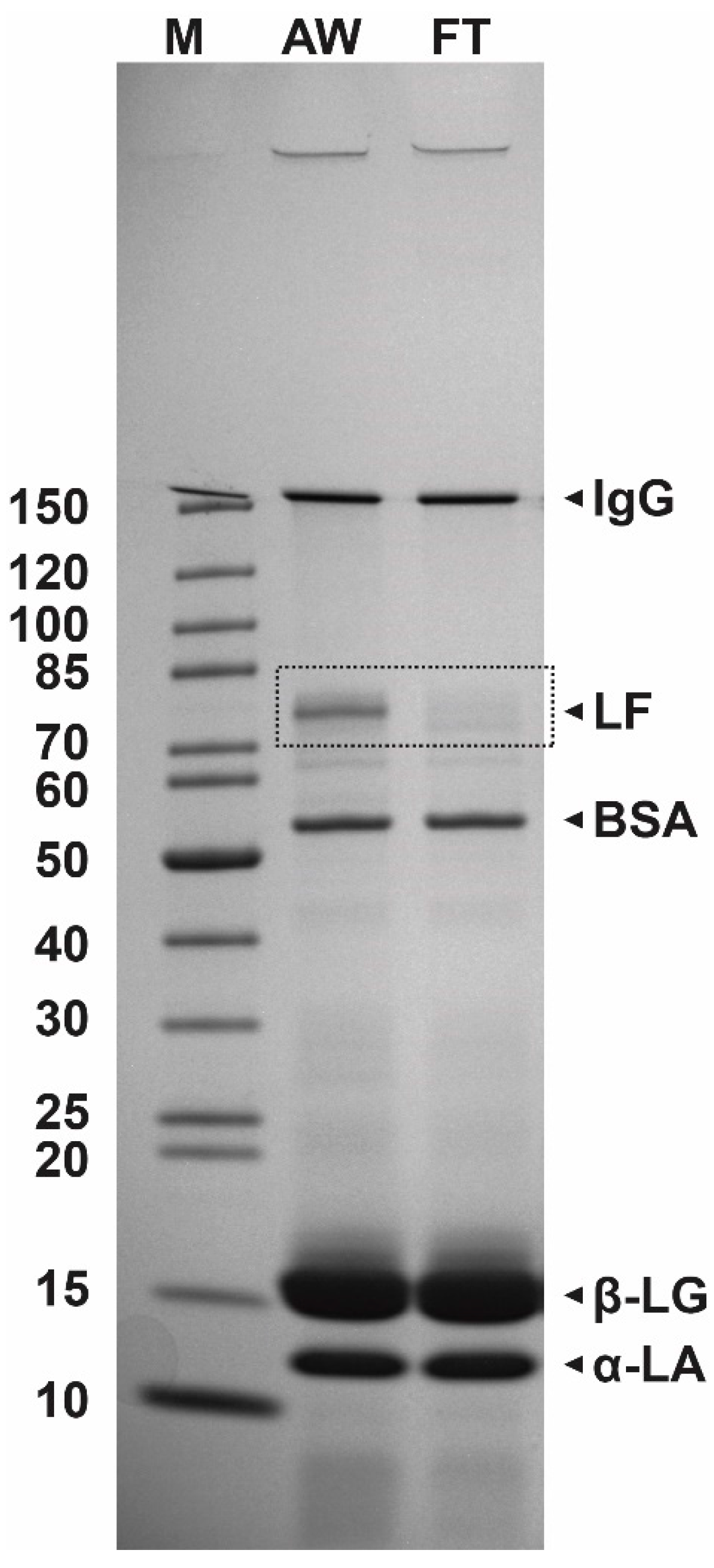
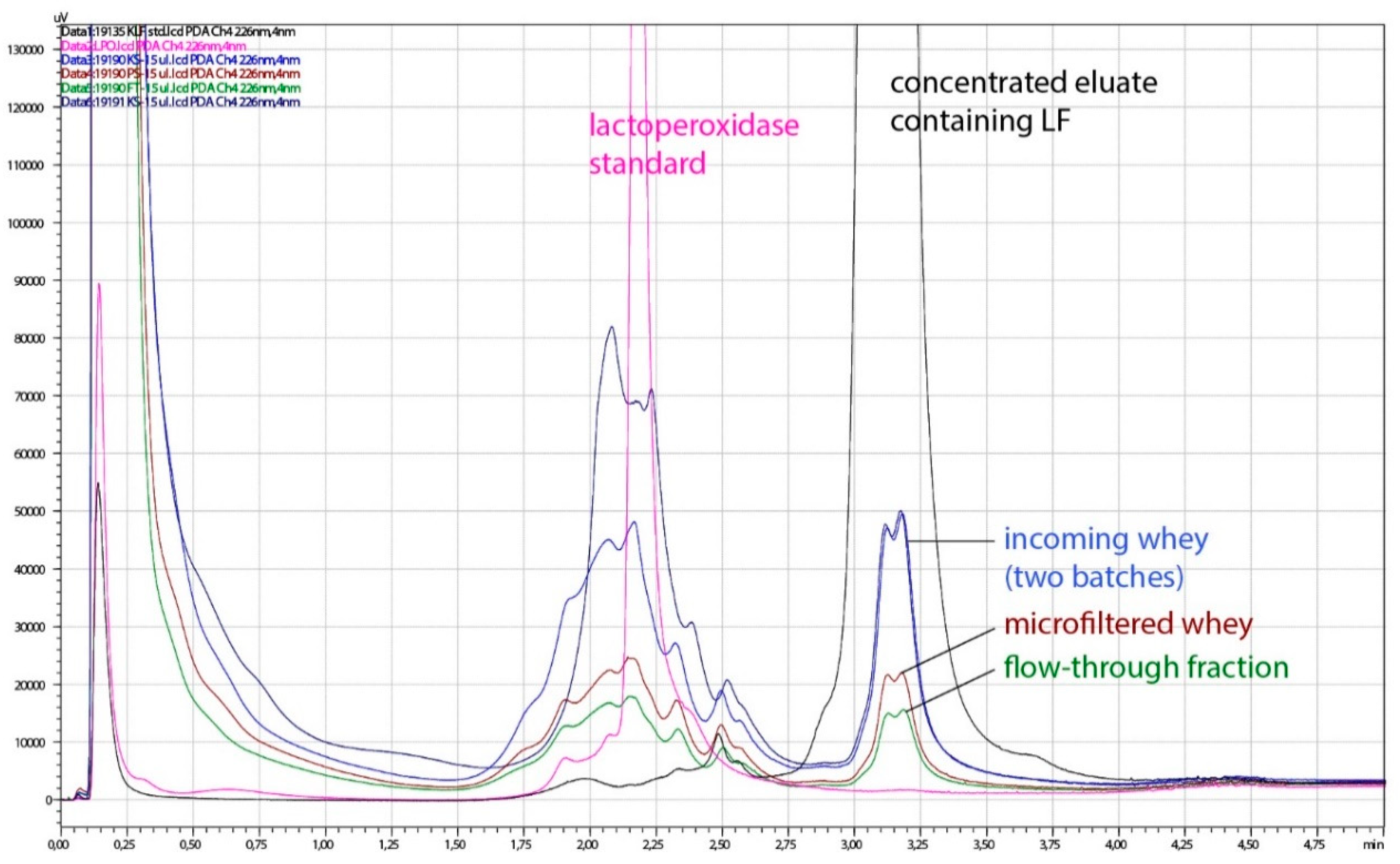
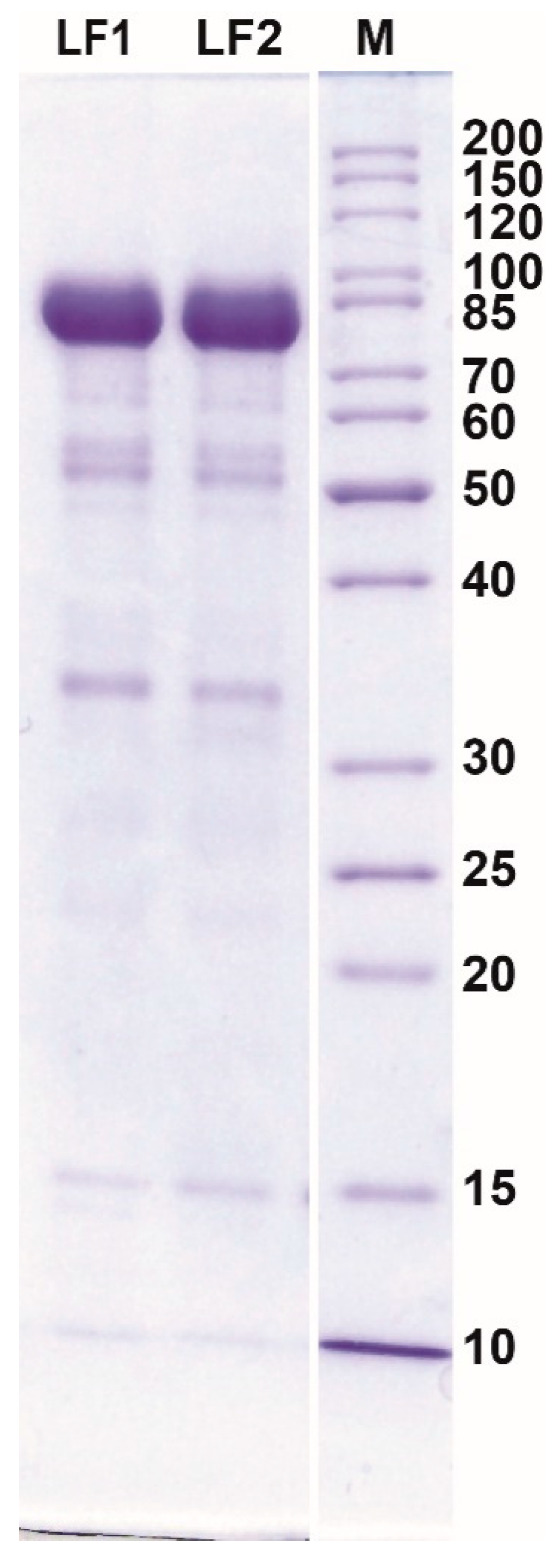


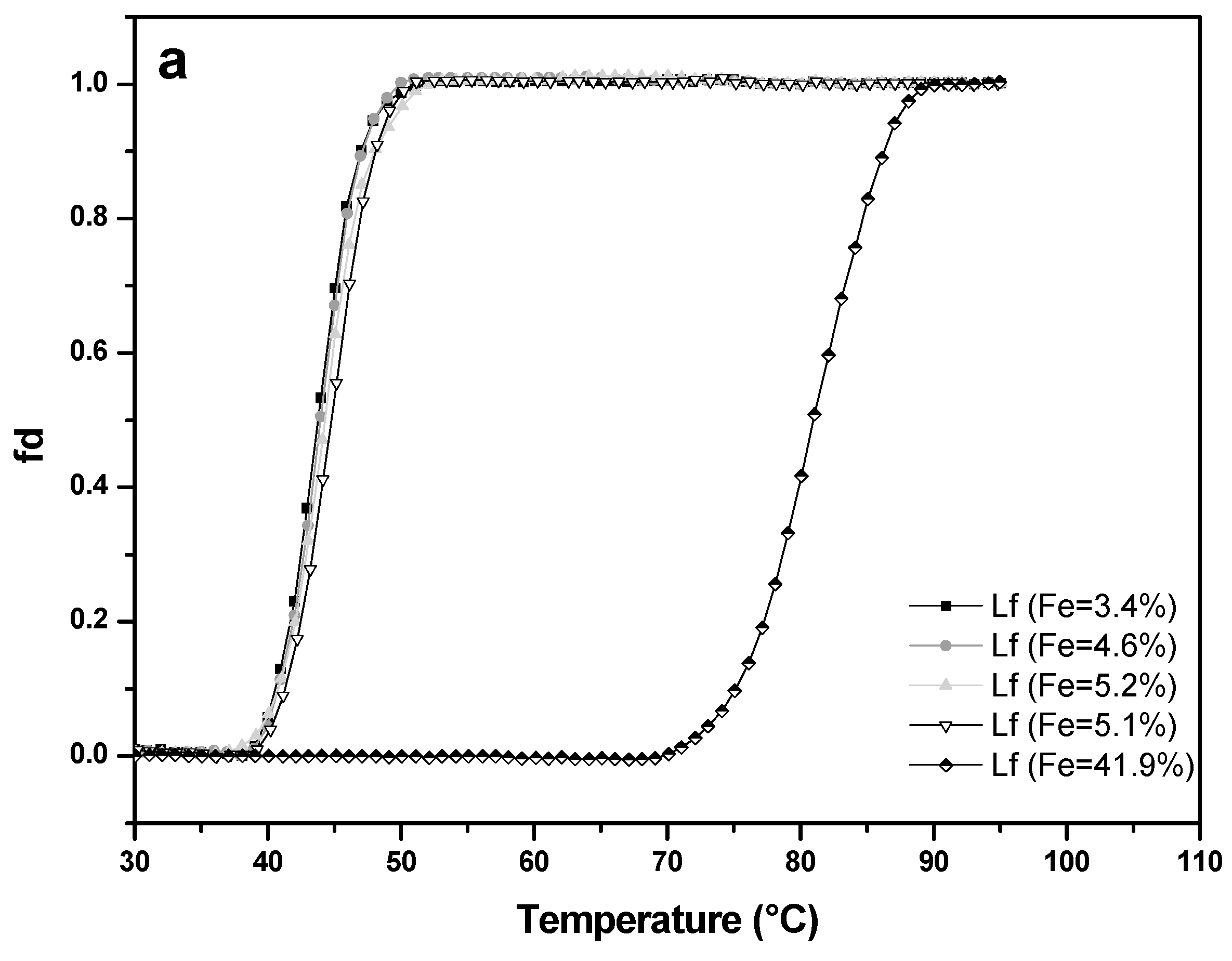
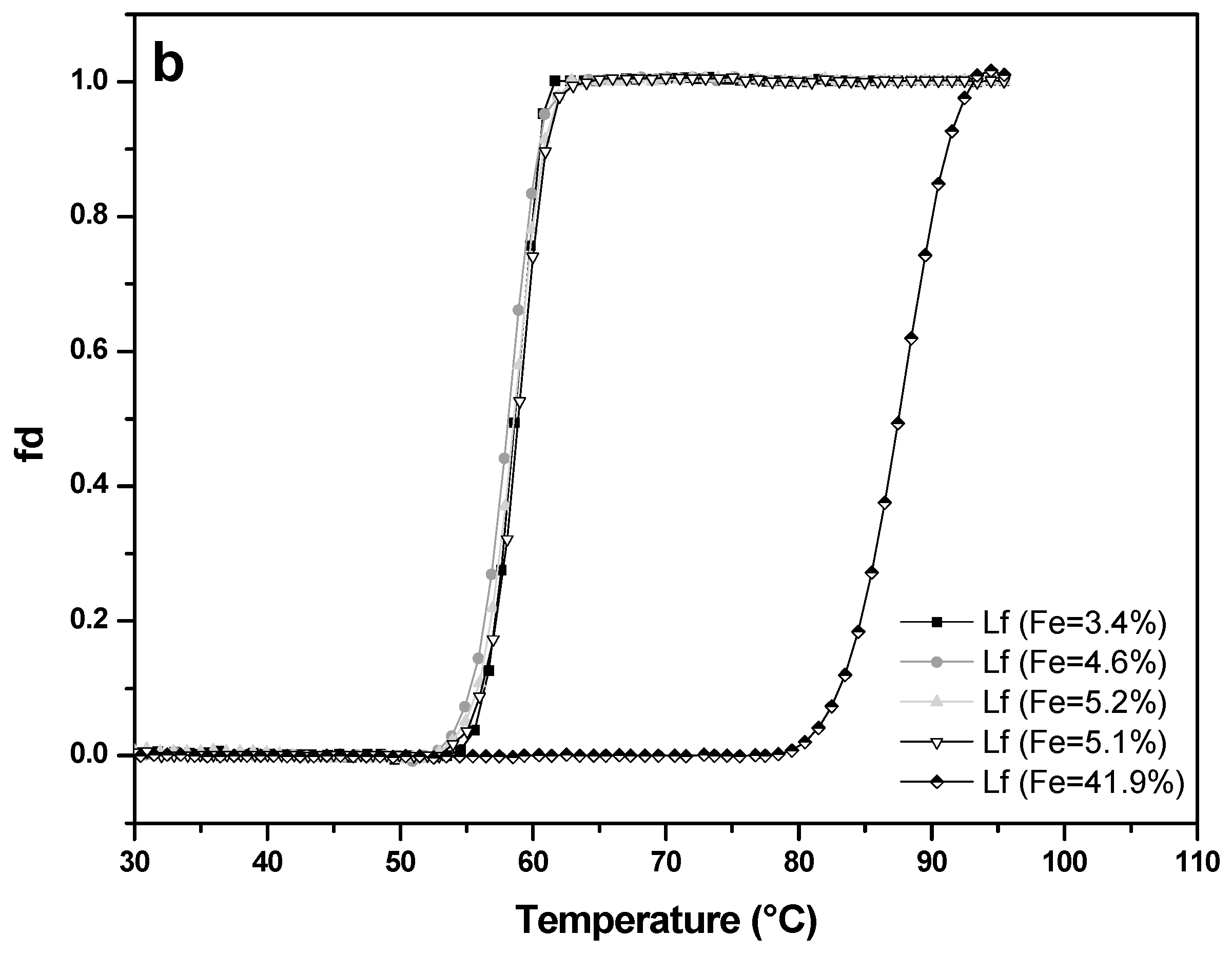
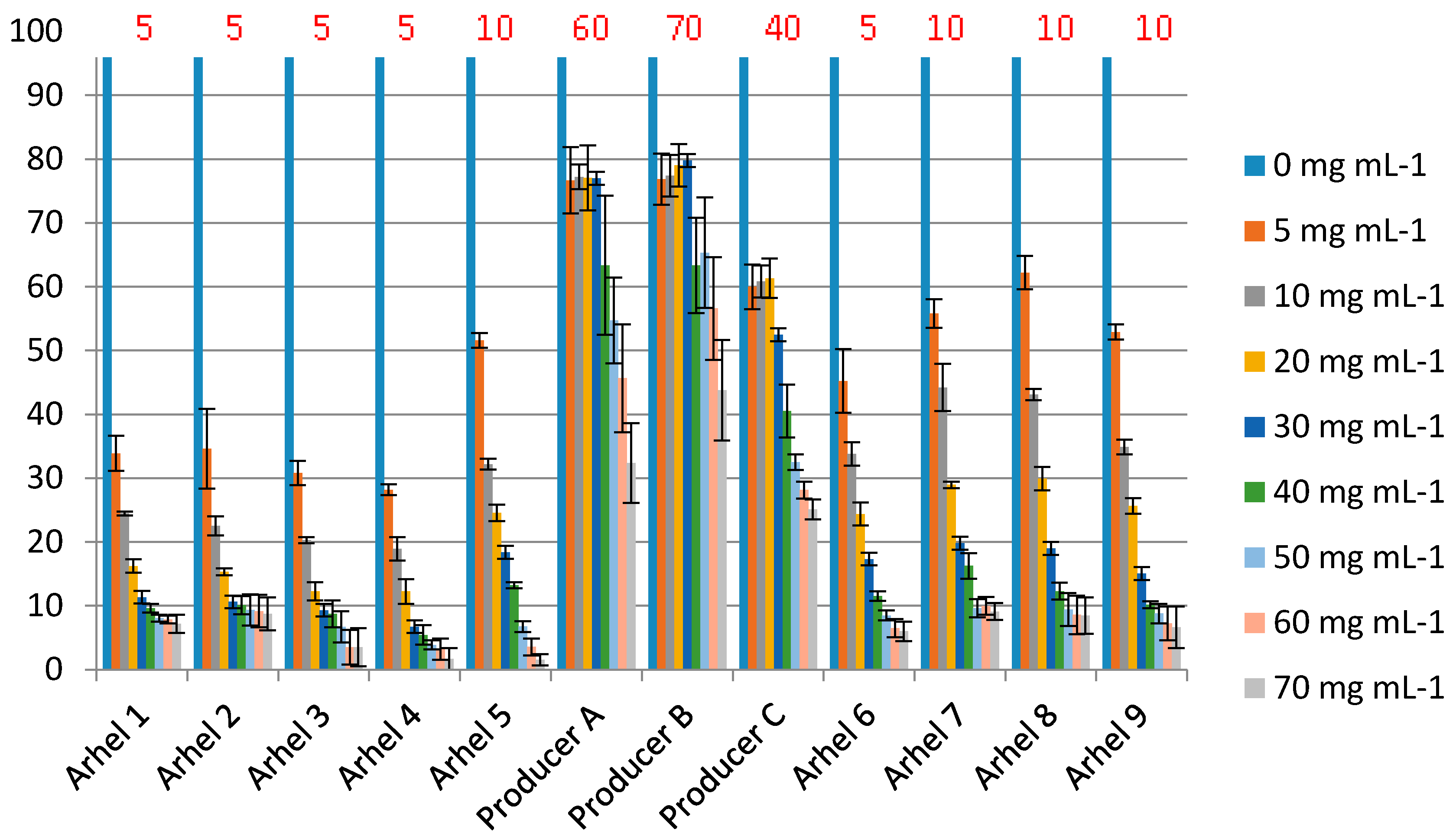

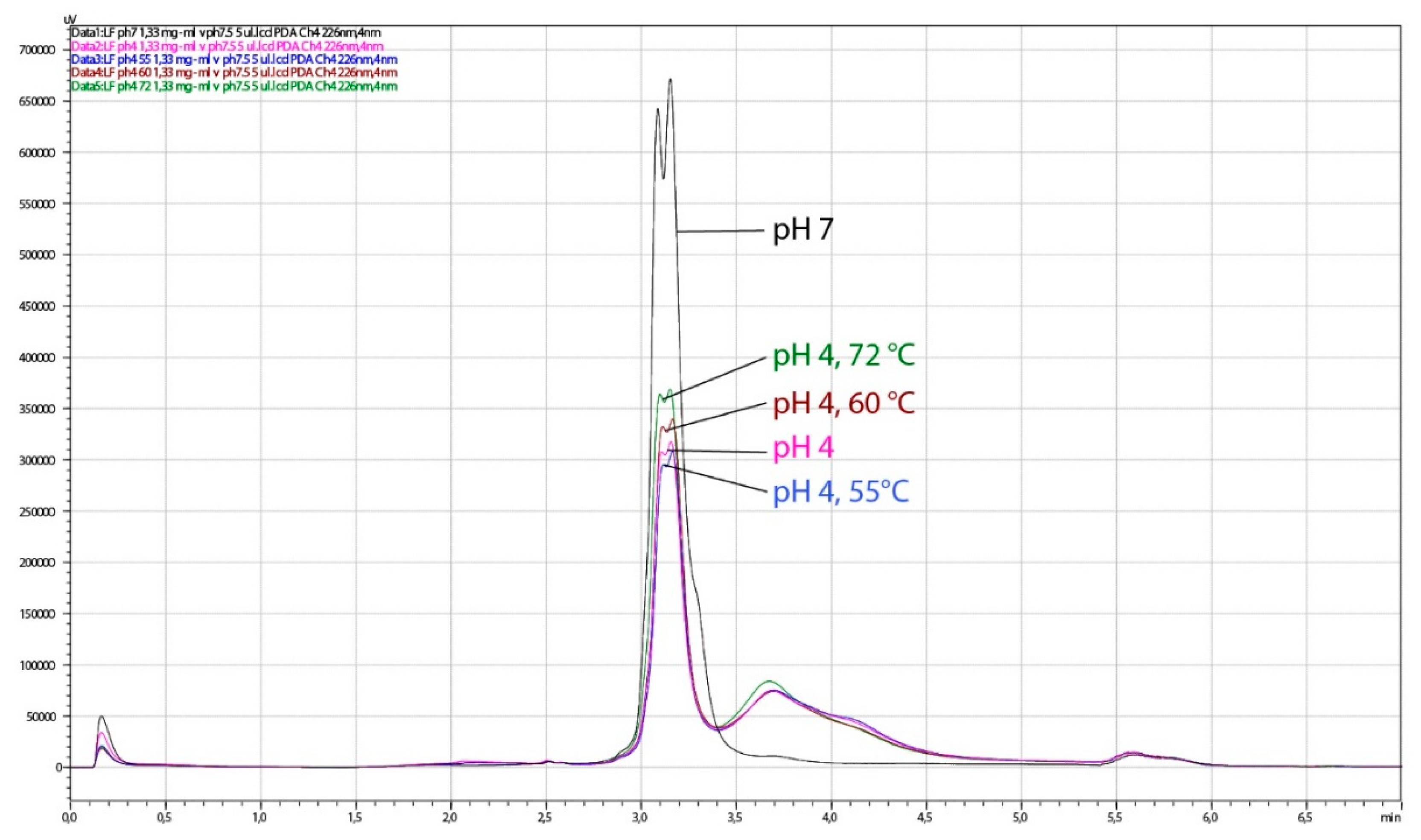
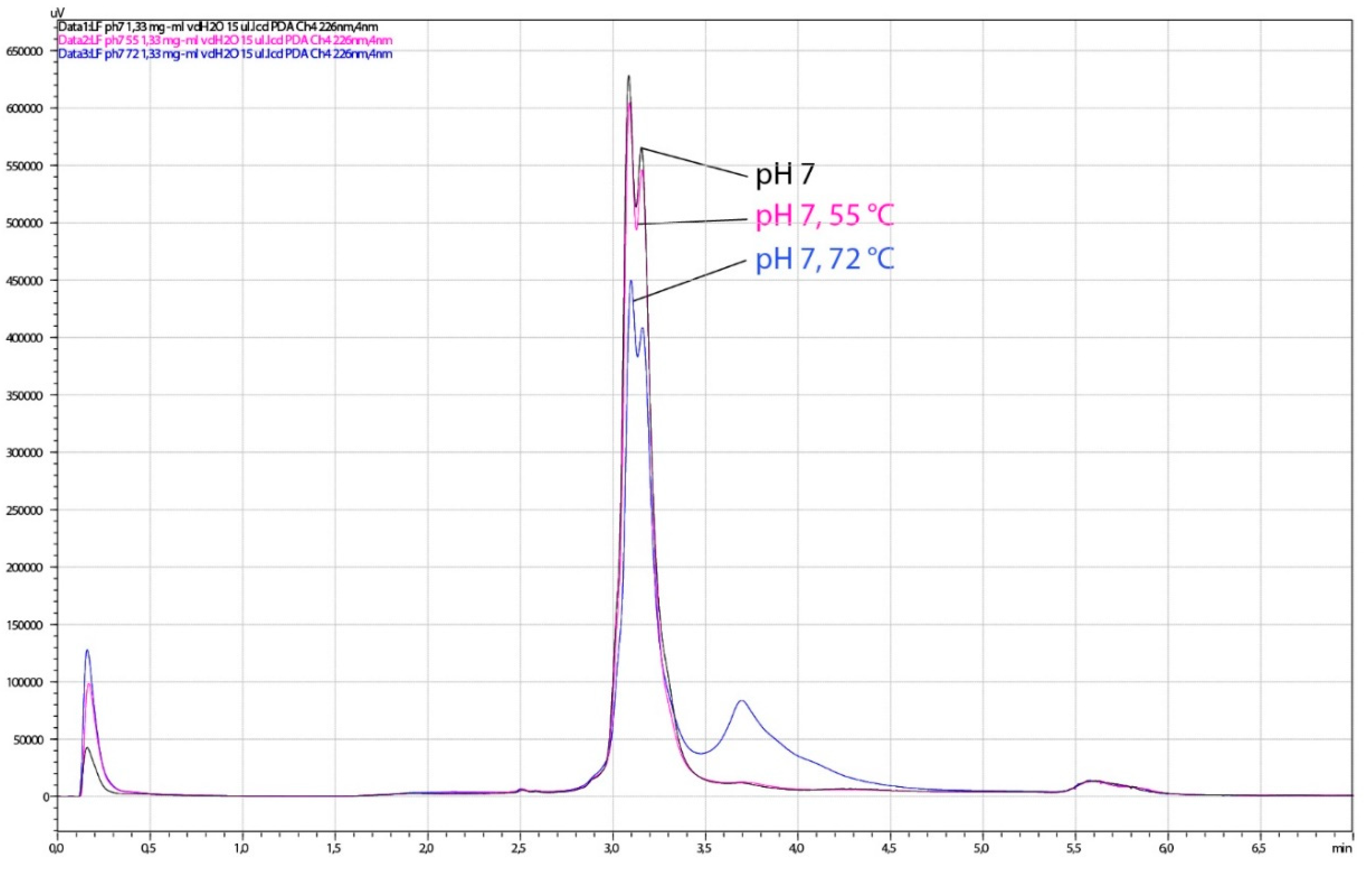
| Parameter | AW Incoming Acid Whey—Celeia (n = 9) | PW Microfiltered Whey (n = 9) | FT Flow-through Whey (n = 9) | |||
|---|---|---|---|---|---|---|
| Average | SEM | Average | SEM | Average | SEM | |
| Fat (g 100 g−1) | 0.03 a | 0.007 | 0.005 b | 0.001 | 0.005 b | 0.001 |
| Proteins (g 100 g−1) | 0.89 a | 0.005 | 0.82 b | 0.028 | 0.80 b | 0.031 |
| Lactose (g 100 g−1) | 4.20 a | 0.027 | 4.04 ± 0.253 ab | 0.073 | 4.035 b | 0.063 |
| Dry matter (g 100 g−1) | 6.53 a | 0.036 | 6.21 b | 0.133 | 6.20 b | 0.120 |
| Ash(g kg−1) | 7.46 | 0.05 | 7.16 | 0.14 | 7.18 | 0.14 |
| Ca (g kg−1) | 1.37 | 0.11 | 1.31 | 0.11 | 1.31 | 0.11 |
| Fe (mg kg−1) | 1.61 | 0.10 | 1.42 | 0.10 | 1.52 | 0.15 |
| P (mg kg−1) | 747.4 | 8.18 | 726.8 | 13.47 | 721.5 | 11.91 |
| K (g kg−1) | 1.86 | 0.03 | 1.77 | 0.04 | 1.77 | 0.04 |
| pH | 4.66 | 0.02 | 4.68 | 0.02 | 4.68 | 0.01 |
| Lactoferrin (mg L−1) | 131.06 a | 7.07 | 121.85 a | 11.68 | 20.79 b | 7.98 |
| Parameters Determined by HPLC | ||
|---|---|---|
| Lactoferrin Sample | LF Concentration (mg mL−1) * | Purity ** |
| LF Arhel 1 | 2.26 | 92.38 |
| LF Arhel 2 | 2.26 | 95.42 |
| LF Arhel 3 | 2.32 | 95.67 |
| LF Arhel 4 | 2.22 | 95.79 |
| LF Arhel 5 | 2.22 | 94.31 |
| LF Arhel 6 | 2.10 | 90.98 |
| LF Arhel 7 | 2.18 | 90.92 |
| LF Arhel 8 | 2.30 | 91.14 |
| LF Arhel 9 | 2.16 | 90.78 |
| LF Producer A | 2.13 | 83.3 |
| LF Producer B | 2.04 | 79 |
| LF Producer C | 3.26 | 87.4 |
| Producer of Lactoferrin | |||||||||
|---|---|---|---|---|---|---|---|---|---|
| Parameter | Producer A | Producer B * | Producer C | Producer D * | Producer E | Producer F | Producer G | Bovine LF Sigma ≥85% | Arhel (n = 10) |
| C-value (%) | 56.7 | 48.6 | 34.4 | 0.0 | 13.8 | 52.1 | 49.2 | 7.5 | 70.0–4.0 |
| A-value (%) | 7.0 | 11.7 | 4.6 | 41.6 | 3.3 | 7.7 | 9.0 | 58.5 | 2–4.9 |
| Overall bioactivity (A + C) (%) | 63.7 | 60.3 | 39.0 | 41.6 | 17.1 | 59.8 | 58.2 | 66.0 | 74.9–76 |
| Indicator Strains | Inhibition of Indicator Strains with Lactoferrin Samples (Arhel) | ||||||
|---|---|---|---|---|---|---|---|
| 1 | 2 | 3 | 4 | 5 | 6 | 7 | |
| Escherichia coli ATCC 25922 | + | + | - | + | + | + | + |
| Escherichia coli O157:H8, IM218 | ++ | ++ | - | ++ | ++ | ++ | ++ |
| Escherichia coli O157:H8 tox-, IM219 | ++ | ++ | - | ++ | ++ | ++ | ++ |
| Escherichia coli O8 K88+ ent−, IM226 | ++ | ++ | - | ++ | ++ | ++ | ++ |
| Staphylococcus aureus ATCC 25923 | + | + | - | + | + | + | + |
| Staphylococcus aureus M41-02 | + | + | - | + | + | + | + |
| Staphylococcus lugdunensis IM157 | ++ | ++ | - | ++ | ++ | ++ | ++ |
| Staphylococcus epidermidis IM206 | ++ | ++ | - | ++ | ++ | ++ | ++ |
| Staphylococcus aureus Rosenbach 1884 AL | + | + | - | + | + | + | + |
| Staphylococcus epidermidis IM591 | ++ | ++ | - | ++ | ++ | ++ | ++ |
| Klebsiella oxytoca IM878 | ++ | ++ | - | ++ | ++ | ++ | ++ |
| Streptococcus salivarius IM175 | + | + | - | + | + | + | + |
| Corynebacterium amycolatum IM178 | ++ | ++ | - | ++ | ++ | ++ | ++ |
| Escherichia coli K12, IM409 | + | + | - | + | + | + | + |
| Listeria monocytogenes IM223 | + | + | + | + | + | + | + |
| Listeria monocytogenes IM221 | + | + | + | + | + | + | + |
| Listeria monocytogenes IM222 | + | + | + | + | + | + | + |
| Salmonella enterica subsp. enterica serovar Enteritidis IM186 | + | + | - | + | + | + | + |
| Salmonella enterica subsp. enterica serovar Brandenburg, CecaLait (France) | + | + | - | + | + | + | + |
| Salmonella enterica serovar Typhimurium ATCC 14028 | + | + | - | + | + | + | + |
| Clostridium difficile IM63 | - | - | - | - | - | - | - |
| Clostridium perfringens IM70 | - | - | - | - | - | - | - |
| Clostridium difficile IM83 | - | - | - | - | - | - | - |
| Clostridium tyrobutyricum IM104 | - | - | - | - | - | - | - |
| Clostridium tyrobutyricum IM233 | - | - | - | - | - | - | - |
| Lactobacillus acidophilus La 5 (Linex forte) | - | - | - | - | - | - | - |
| Bifidobacterium animalis ssp. lactis BB 12 (Linex Forte) | - | - | - | - | - | - | - |
| Lactobacillus reuteri DSM 17938 (BioGaia) | - | - | - | - | - | - | - |
| Lactobacillus gasseri K7, IM105 (infant’s feces) | - | - | - | - | - | - | - |
| Lactobacillus delbrueckii spp. bulgaricus ATCC 11842 | - | - | - | - | - | - | - |
| Streptococcus thermophilus IM 410 (bolgarian yogurt) | - | - | - | - | - | - | - |
| Lactobacillus plantarum IM 1008 (Emmental cheese) | - | - | - | - | - | - | - |
| Lactobacillus paracasei IM 1073 (Gauda cheese) | - | - | - | - | - | - | - |
| Lactobacillus acidophilus IM 1074 (Camembert cheese) | - | - | - | - | - | - | - |
| Lactobacillus casei IM 1106 (Emmental cheese) | - | - | - | - | - | - | - |
© 2020 by the authors. Licensee MDPI, Basel, Switzerland. This article is an open access article distributed under the terms and conditions of the Creative Commons Attribution (CC BY) license (http://creativecommons.org/licenses/by/4.0/).
Share and Cite
Matijašić, B.B.; Oberčkal, J.; Mohar Lorbeg, P.; Paveljšek, D.; Skale, N.; Kolenc, B.; Gruden, Š.; Poklar Ulrih, N.; Kete, M.; Zupančič Justin, M. Characterisation of Lactoferrin Isolated from Acid Whey Using Pilot-Scale Monolithic Ion-Exchange Chromatography. Processes 2020, 8, 804. https://doi.org/10.3390/pr8070804
Matijašić BB, Oberčkal J, Mohar Lorbeg P, Paveljšek D, Skale N, Kolenc B, Gruden Š, Poklar Ulrih N, Kete M, Zupančič Justin M. Characterisation of Lactoferrin Isolated from Acid Whey Using Pilot-Scale Monolithic Ion-Exchange Chromatography. Processes. 2020; 8(7):804. https://doi.org/10.3390/pr8070804
Chicago/Turabian StyleMatijašić, Bojana Bogovič, Jernej Oberčkal, Petra Mohar Lorbeg, Diana Paveljšek, Nina Skale, Borut Kolenc, Špela Gruden, Nataša Poklar Ulrih, Marko Kete, and Maja Zupančič Justin. 2020. "Characterisation of Lactoferrin Isolated from Acid Whey Using Pilot-Scale Monolithic Ion-Exchange Chromatography" Processes 8, no. 7: 804. https://doi.org/10.3390/pr8070804
APA StyleMatijašić, B. B., Oberčkal, J., Mohar Lorbeg, P., Paveljšek, D., Skale, N., Kolenc, B., Gruden, Š., Poklar Ulrih, N., Kete, M., & Zupančič Justin, M. (2020). Characterisation of Lactoferrin Isolated from Acid Whey Using Pilot-Scale Monolithic Ion-Exchange Chromatography. Processes, 8(7), 804. https://doi.org/10.3390/pr8070804






